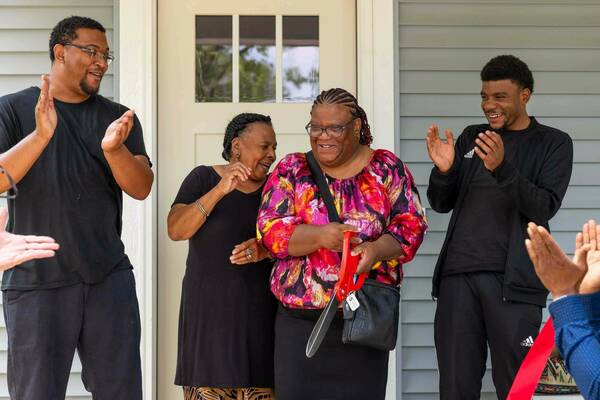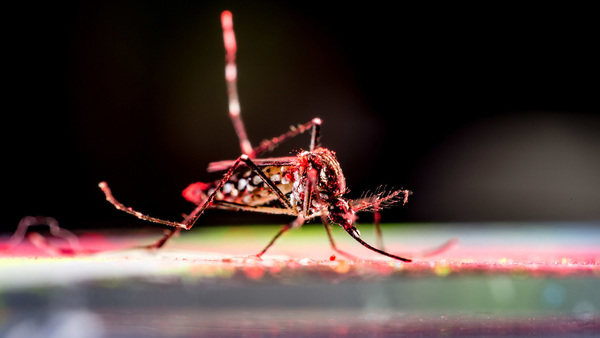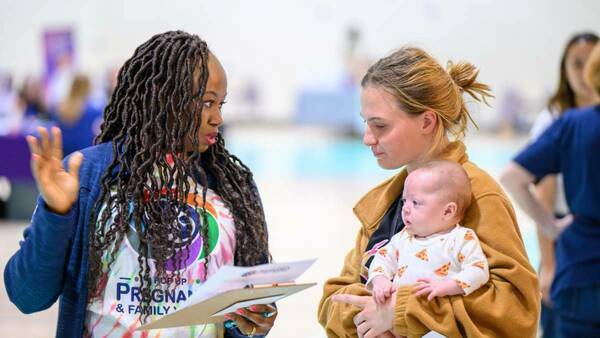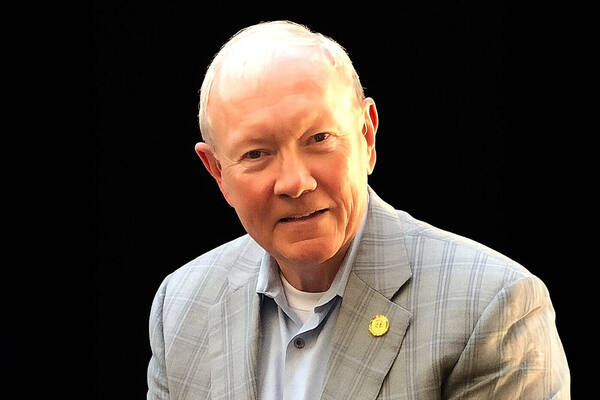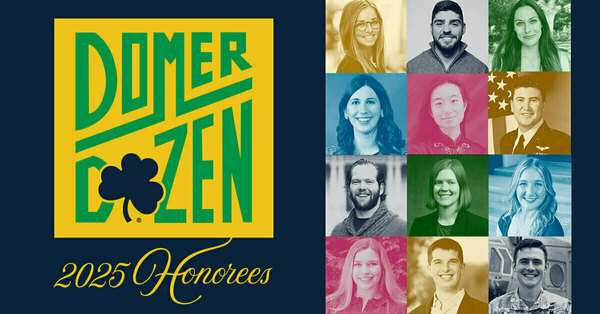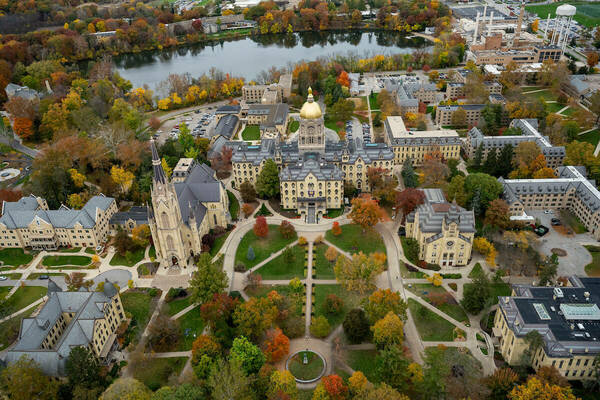One year later, Inauguration Build a ‘dream come true’ for Habitat families

Hammer in hand, University of Notre Dame President Rev. Robert A. Dowd, C.S.C., joined with fellow members of the Notre Dame community in September of last year to help Habitat for Humanity of St. Joseph County build five new homes in South Bend as part of Inauguration Build 2024, a weeklong service project tied to his official inauguration earlier in the month.
Reflecting during a kick-off event for the project on the meaning and purpose of it, Father Dowd, trading his traditional collar for jeans, work boots and a quarter zip, harkened to his inaugural address, saying, in part, “I talked about how South Bend and Notre Dame share a future. We also share a present. And in many ways, coming together like this is all about … that present that we share, that future that we share.”

Moreover, he described access to decent, affordable housing as a basic human right, consistent with Catholic teaching.
“We’re talking about housing that is befitting of the dignity of each and every human being, and having decent housing is so important for anyone to realize his or her potential,” he said. “So this is a great opportunity to come together in respect of human dignity — the God-given dignity that each and every one of us has.”
One year later, work on the project, in the 700 block of Harrison Avenue, is finally complete, offering shelter and so much more to five local families.
Where once abandoned houses and weed-filled lots stood, now five new houses brighten the block — part of an effort to revitalize a once thriving neighborhood battered by the effects of deindustrialization and suburban flight, but now on the upswing thanks to investment from the city and others.
The project, in the city’s Near Northwest Neighborhood, was a close collaboration between Habitat and Notre Dame’s Office of Public Affairs, with support from the Office of the President, the School of Architecture and the Notre Dame student chapter of Habitat for Humanity, among the largest and oldest such chapters in the nation.

The University, in recognition of Father Dowd, sponsored one of the houses, helping to subsidize its cost. The student Habitat chapter organized a wall build on campus. Third-year architecture students, led by Associate Professor of the Practice John Mellor, designed the houses as part of an existing relationship with Habitat.
The City of South Bend also took part, donating the land as part of an effort to repurpose newly vacant lots through its vacant and abandoned housing initiative.
Ultimately, more than 900 students, faculty and staff participated in the project, assisting with framing and other tasks in a spirit of faith, service and community consistent with Notre Dame’s mission, values and strategic framework, which calls for further engagement to promote economic and social well-being in the South Bend-Elkhart region.
“As Father Dowd has shared on multiple occasions, for Notre Dame to thrive, South Bend must also prosper. And for South Bend to prosper, access to decent, affordable housing is a must,” said Tim Sexton, associate vice president for Public Affairs. “We join with Habitat in celebrating the completion of this project and in congratulating those who, as a result, have been able to realize the dream of homeownership.”
‘A dream come true’
Joined by friends and family, Garion Hoskins, who grew up in South Bend and recently completed his master’s degree in social work, moved into the last of the five houses — what’s affectionately been dubbed the “Father Bob House” for Father Dowd’s work on the structure — on Sept. 19.
As part of a special “key ceremony,” Habitat leadership congratulated Hoskins and presented him with several housewarming gifts, including a Bible, a handmade scarf and, courtesy of Cultivate Food Rescue and the Food Bank of Northern Indiana, a fully stocked fridge and pantry.
“This is a special build,” Jim Williams, president and CEO of Habitat for Humanity of St. Joseph County, said, noting Father Dowd’s involvement. “Congratulations,” he said to Hoskins. “We know you’ve worked very hard for this.”

Clare Roach, associate director of Notre Dame’s Robinson Community Learning Center, presented Hoskins with a cedar planter box with a brightly colored chrysanthemum and a birdhouse, both made by Robinson Center students.
“I will tell you that we learned at the Robinson Center this week that mums like water, so I will advise you to water the mum every day,” Roach joked, adding, in a more earnest tone, “I hope it (the planter) helps you realize this is a home now and not just a house.”
As required of all Habitat homeowners, Hoskin worked alongside volunteers to build his own home. Wielding a variety of tools, he contributed “sweat equity” to the project while at the same time participating in homeownership education classes covering repair and maintenance, saving, managing a mortgage and maintaining personal finances.
Dressed nattily in dark slacks and an olive green sweater, he arrived at the key ceremony directly from the title company, where he had just finished signing his closing documents.
“It’s everybody’s dream as a kid to have a big house, something to call your own,” Hoskins said. “And for some people, that’s just what it is, a dream. So to see it come to fruition is a dream come true.”
A confluence of decisions led to this point.
In 2013, the city announced an effort to repair or demolish 1,000 vacant and abandoned houses in 1,000 days in order to boost property values, improve public safety and encourage investment — particularly in distressed areas of the city hit hard by disinvestment and blight.
At the same time, the city removed roadblocks and created incentives for individuals and organizations to build new market-rate and affordable housing, drawing the attention of investors and community development organizations and leading to a boost in supply.

Following in the city’s wake, Notre Dame launched its own effort to improve access to affordable housing directly south of campus as a founding member of the Northeast Neighborhood Revitalization Organization (NNRO), which played a catalytic role in the development of Eddy Street Commons.
In 2023, the University donated land to Habitat and worked closely with the organization to build as many as seven new houses in the neighborhood. It also donated $250,000 to the organization — $50,000 per year over five years — from an anonymous donor to help with construction costs.
The following year, the University donated land to the NNRO in support of a newly formed community land trust, the first of its kind in Indiana, designed to preserve access to affordable housing amid rising property values.
It was only a matter of time before the city’s efforts and Notre Dame’s efforts converged, which they finally did along Harrison, with the city donating the land and Notre Dame providing financial support and labor.
"This collaboration proves what is possible when we work together and invest in our neighborhoods and our residents," said South Bend Mayor James Mueller. "Quality, attainable housing now fills previously vacant lots, and families in our community have a pathway to homeownership. The City looks forward to building on partnerships like this one with Habitat for Humanity and the University of Notre Dame."
Back in the Near Northwest Neighborhood, Derri Chase, the mother of two adult children, has been settling into her new house, two doors down from Hoskins, since August. The one-and-a-half-story home features a covered front porch and lap and shingle siding.
“It took me a long time to become a homeowner,” said Chase, a unit assistant at Beacon Health System, citing past health issues and unresolved debt.
Now, she said, she has the stability of a forever home, more space for family, including her grandkids, and something tangible to leave her children.
For that, she said, she is forever thankful, to Habitat as well as Notre Dame.
Latest ND NewsWire
- Researchers deconstruct chikungunya outbreaks to improve prediction and vaccine developmentThe symptoms come on quickly — acute fever, followed by debilitating joint pain that can last for months. Though rarely fatal, the chikungunya virus, a mosquito-borne illness, can be particularly severe for high-risk individuals, including newborns and older adults. While the virus is common…
- Eck Institute investigator to strengthen postpartum care for Indiana mothersYenupini Joyce Adams, associate professor of the practice and maternal health lead for the Eck Institute for Global Health at the University of Notre Dame, is partnering with Beacon Health System to pilot a new, first-of-its-kind postpartum care model in the South Bend-Elkhart community.
- Gen. Martin Dempsey to speak at Notre Dame Forum event on ‘Hope, Global Stability and the Role of the United States’Gen. Martin Dempsey, the retired 18th chairman of the Joint Chiefs of Staff, will join University President Rev. Robert A. Dowd, C.S.C., for a fireside chat at 4 p.m. Friday (Oct. 10), as part of the 2025-26 Notre Dame Forum. The discussion, titled “Hope, Global Stability and the Role of the United States,” is part of the exploration of this year’s Notre Dame Forum theme, “Cultivating Hope.” It will take place in Rooms 215/216 of McKenna Hall and will also be livestreamed. The event is free and open to the public.
- University of Notre Dame joins the Global Coalition of Ukrainian StudiesThe University of Notre Dame has joined the Global Coalition of Ukrainian Studies after signing a memorandum of cooperation, formalized Sept. 24, at the Ukrainian Institute of America in New York City. Notre Dame joined four other American institutions that were also publicly welcomed to the coalition at this event: Arizona State University, Columbia University, Manor College and the Shevchenko Scientific Society.
- Alumni Association and YoungND honor 2025 Domer DozenThe Notre Dame Alumni Association announced its 2025 Domer Dozen cohort, honoring 12 graduates ages 32 and younger for excellence in their contributions in learning, service, faith and work — the core pillars of the association’s mission.
- Faculty receive prestigious early career awards from National Science FoundationDuring the 2024-25 academic year, four researchers in the University of Notre Dame’s Colleges of Engineering and Science received early-career awards from the National Science Foundation.



